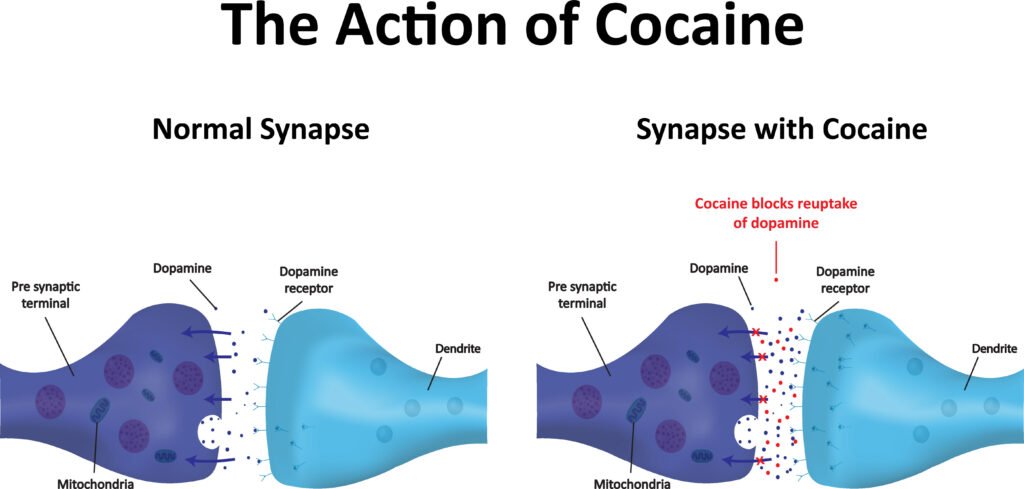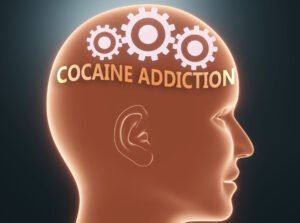Jump to: Cocaine Addiction | Effects of Usage | Cocaine Withdrawal
According to data from the Substance Abuse and Mental Health Services Administration (SAMHSA), 1.9 million Americans aged 12 and older had used cocaine within the previous month as of 2018, and 5.5 million had used it within the past year. This is equal to 2 percent of the population aged 12 and above using cocaine.
The prevalence of cocaine use is concerning, given the dangers associated with this drug. Some people may develop serious consequences with cocaine use and require treatment to stop using it; these consequences can include cocaine addiction and withdrawal.
What is Cocaine?
As the National Institute on Drug Abuse (NIDA) has explained, cocaine is highly addictive stimulant drug derived from the leaves of the South American coca plant. On occasion, doctors may utilize this drug as a local anesthetic during surgeries, but it is illegal to use cocaine recreationally. People can abuse cocaine by snorting the powder version of the drug through a straw, or by processing cocaine to create a rock formation. People refer to the rock as “crack cocaine” and smoke it using a pipe. It is also possible to dissolve cocaine and inject it into the veins.
Regardless of how people use cocaine, when they take this drug, it increases the levels of a brain chemical called dopamine, which is responsible for movement and reward. This means that cocaine has a pleasurable effect, according to NIDA.

Effects & Side Effects of Cocaine Usage
Side Effects
Beyond the immediate effects associated with a cocaine high, some rather unpleasant side effects can occur when a person uses this drug. According to NIDA, these side effects are as follows:
- Tightening of the Blood Vessels
- Dilated Pupils
- Nausea
- Elevated Blood Pressure
- Fast or Abnormal Heartbeat
- Tremors
- Twitching
- Restlessness
- High Body Temperature
In some cases, the side effects of cocaine use can be serious, because in high enough doses, use can lead to a life-threatening overdose. Some of the health problems associated with cocaine overdose, per NIDA, are breathing problems, irregular heart rhythm, heart attack, seizures, and stroke. Since cocaine can cause these serious problems, even one use of the drug can lead to death. Other overdose symptoms include hallucinations as well as extreme anxiety or agitation. While cocaine may seem less deadly than drugs like heroin, it is important to understand that its effects are short-lasting. This means that over the course of a day or evening, people may take repeat doses of cocaine to stay high, which can put them at a higher risk of overdosing on cocaine.

A cocaine overdose requires emergency medical treatment, as a person is at risk of death from heart attack or stroke. In case of an overdose, medical staff will work to restore blood to the heart or brain if a person has suffered heart attack or stroke. If a cocaine overdose leads to seizure, the goal of medical treatment is to stop the seizure. Unlike with a heroin overdose, there is no medication that can reverse the effects of cocaine overdose, so medical personnel must provide the best treatment possible to address specific overdose symptoms.
Short-Term Effects
While cocaine can produce pleasurable feelings and result in a “high,” not all of the outcomes of cocaine use are pleasant. Cocaine can make people feel happy, alert, and energetic, but it can also heighten the senses and make them especially sensitive to sights and sounds. Using cocaine can also result in irritability and may even make people paranoid, meaning they are extremely distrustful of those around them.
These effects of cocaine are relatively short-lived but can vary based upon how a person uses the drug. When people smoke or inject cocaine, they experience a more intense high, but it typically lasts only five to 10 minutes, whereas a high from snorting cocaine can last as long as a half-hour. The effects of cocaine appear almost immediately after a person uses the drug, but because they fade quickly, people may take repeat doses of cocaine. This can lead to dangerous short-term effects, as a person’s behavior may become violent or erratic with large doses of cocaine.
Long-Term Effects
Using cocaine just one time can lead to serious health problems, and long-term use of the drug is also dangerous. According to NIDA, people who snort cocaine may suffer from bloody noses, frequent runny nose, swallowing difficulties, and a loss of the sense of smell. Smoking crack cocaine can lead to cough, asthma, pneumonia, and breathing problems. When people inject cocaine with a needle, they are at risk of skin infections, scarring, collapsed veins, and bloodborne illnesses, such as HIV and hepatitis C. Long-term cocaine use can also lead to malnourishment, and after years of use, people can develop Parkinson’s disease.
Cocaine Addiction
Another long-term consequence of cocaine use, aside from numerous health-related problems, is the risk of cocaine addiction. This occurs with repeat cocaine use, which affects the way the brain experiences pleasure. Over time, the brain adapts to the dopamine surge that cocaine creates and is less responsive to it. This leads people to take high doses of cocaine and to seek it out frequently, because they need larger amounts of the drug to feel the same pleasurable effects.

When a person develops a cocaine addiction and seeks treatment, an addiction professional will diagnose a stimulant use disorder, which is the clinical term for cocaine addiction. A professional diagnoses a stimulant use disorder based upon criteria in the Diagnostic and Statistical Manual of Mental Disorders, 5th Edition. According to this manual, the following are symptoms of a stimulant use disorder involving cocaine:
- Cocaine cravings
- Being unable to reduce or control cocaine use
- Struggling to fulfill duties at work or home due to cocaine use
- Using greater amounts of cocaine than intended
- Cocaine use under circumstances where it is physically hazardous
- Continuing to use cocaine even when it causes relationship problems
- Cocaine use despite health problems being caused or worsened by the drug
- Giving up important activities because of cocaine
- Spending large amounts of time using and seeking cocaine
- Developing a tolerance for cocaine
- Experiencing cocaine withdrawal
It is helpful to review some examples of how some of the different symptoms of a stimulant use disorder may appear. For instance, cocaine use despite health problems may occur when a person continues to use cocaine, even if it is causing high blood pressure and heart palpitations. Furthermore, cocaine use under physically hazardous circumstances could include continuing to use large quantities of cocaine that lead to a life-threatening overdose. Finally, a person may stay up all night binging on cocaine and be unable to report to work on time in the morning, causing failure to fulfill duties at work.
Treatment for Cocaine Addiction
Detox programs can help people to overcome initial cocaine withdrawal symptoms, but additional treatment is necessary to address the underlying issues that contributed to addiction. A detox program is equipped to alleviate withdrawal symptoms, but ongoing psychological treatment is a part of an effective cocaine addiction treatment program. Psychological care is especially relevant in cases of protracted withdrawal, where people may feel anxious or have severe mood swings.

According to NIDA, cognitive behavioral therapy is one form of psychological treatment for cocaine addiction. In this type of treatment, people can overcome unhealthy thinking patterns surrounding drug use and learn to replace them with helpful ways of thinking. For example, a person may think that cocaine use is necessary for coping, but during cognitive behavioral therapy, he or she could be prompted to think of times that coping was possible without drug use. This can help to change thinking patterns that contribute to addiction.
Another viable treatment option for cocaine addiction is contingency management. In this type of program, people receive rewards for maintaining sobriety. For instance, if a person has a negative drug screen, he or she may be given a voucher to redeem for a prize or free movie tickets. As a person has more and more negative drug screens, the value of rewards increases, but a positive screen can start a person over at the lowest value reward. This provides an incentive to remain sober.
Relapse prevention programming is also a part of cocaine addiction treatment. People may attend relapse prevention groups, where they discuss relapse triggers and ways to overcome them. Led by a counselor, these groups give people an opportunity to learn from others who are also struggling with addiction. In a relapse prevention group, those who are recovering from cocaine addiction can identify the triggers that make them vulnerable to relapse and decide upon a plan for resisting these triggers. For instance, a person may decide that when stressed and faced with drug cravings, he or she will call a relative or go for a walk until the craving passes.
In addition to the various psychological strategies used to treat cocaine addiction, NIDA reports that some programs may utilize medications. For example, disulfiram, used to treat alcohol addiction, may be beneficial for cocaine addiction. Researchers are also exploring the benefits of buprenorphine, which is commonly used to treat opiate addiction, for use with individuals addicted to cocaine.
Cocaine Withdrawal
Cocaine Withdrawal Symptoms
As previously noted, one of the symptoms of cocaine addiction is withdrawal. When a person undergoes cocaine withdrawal, he or she is likely to experience a variety of unpleasant symptoms. These cocaine withdrawal symptoms are uncomfortable and can make it difficult for a person to stop using cocaine. According to NIDA, common cocaine withdrawal symptoms include:
- Depressed Mood
- Fatigue
- Increase in Appetite
- Sleep Problems
- Disturbing Dreams
- Slowed Thinking

The World Health Organization has also provided a description of other withdrawal symptoms associated with stimulants. These include muscle aches, an increase in sleep duration, and agitated or irritable behavior. Because cocaine is a stimulant drug, people may also experience some of these general stimulant withdrawal symptoms when they stop using cocaine. In rare cases, people may experience some extreme psychiatric symptoms during stimulant withdrawal, such as paranoia, hallucinations, and disordered thinking. These symptoms are possible with cocaine withdrawal but are more common when withdrawing from methamphetamine, which is also a stimulant.
Beyond withdrawal symptoms, it is also important to understand the cocaine withdrawal timeline to know how long these symptoms will last. Per the World Health Organization, most symptoms of stimulant withdrawal begin within a day of a person’s last drug use and continue for three to five days. A person can expect to feel initial withdrawal symptoms rather soon after giving up cocaine, but these symptoms should pass in less than a week.
Cocaine Withdrawal Treatment
Given the fact that cocaine withdrawal can be uncomfortable, people may seek treatment to assist with withdrawal symptoms. A detox program can provide cocaine withdrawal treatment and help people to cope with the discomfort of withdrawal symptoms. In an inpatient detox program, medical staff can provide medications to address specific symptoms, such as aches or anxiety. They also monitor patients regularly for psychiatric issues. Those who have severe problems, such as psychotic behavior, may need to be sent to a hospital for treatment.
In addition to treating symptoms and monitoring patients, medical staff in a detox program will ensure that patients receive proper nutrition while undergoing cocaine withdrawal. The World Health Organization recommends that patients drink sufficient amounts of water during detox and take a supplement including B vitamins and vitamin C.
Protracted Withdrawal
While a detox program can treat the initial withdrawal symptoms that occur after a person stops using cocaine, it is also important to address the issue of protracted withdrawal. Initial withdrawal symptoms generally pass within three to five days, but protracted withdrawal includes symptoms that persist for a month or two after people give up cocaine. Per the World Health Organization, cocaine’s protracted withdrawal symptoms include:
- Lack of energy
- Anxiety
- Irregular sleep patterns
- Emotional instability
The protracted withdrawal symptoms associated with cocaine can make it difficult to stay sober. A person who struggles with protracted cocaine withdrawal may feel helpless or discouraged and be triggered to return to cocaine abuse. It is important that people who are undergoing cocaine withdrawal treatment understand that protracted withdrawal is a normal part of recovering from cocaine addiction, and like initial withdrawal symptoms, protracted withdrawal will also pass.
Cocaine Addiction & Withdrawal FAQs

Detox programs and ongoing psychological treatment are often necessary for those recovering form cocaine withdrawal and addiction. Beyond understanding this fact, the following frequently-asked questions (FAQs) can provide a brief description of the facts surrounding cocaine withdrawal:
What is cocaine withdrawal like?
Based upon the common symptoms reported with cocaine withdrawal, a person can expect to feel tired, experience increased hunger, and struggle with feelings of depression and difficulty thinking while undergoing cocaine withdrawal. A person who is in the midst of cocaine withdrawal may also have bad dreams and struggle to sleep.
How long does cocaine withdrawal last?
Most symptoms of cocaine withdrawal will pass within three to five days, but people may experience protracted withdrawal, which involves unstable emotions, low energy, anxiety, and disturbed sleep for up to a month or two after they stop using cocaine.
How can I deal with cocaine withdrawal?
The best way to cope with cocaine withdrawal is to seek out a professional detox program to help you manage the uncomfortable side effects. A detox program can alleviate some of the negative symptoms of cocaine withdrawal and make it easier for you to stop using. After initial withdrawal passes, it is important to seek ongoing addiction treatment to help you manage underlying causes of addiction and cope with protracted withdrawal.
Cocaine withdrawal is uncomfortable, but with a detox program, it is possible to manage the symptoms. Withdrawal is a temporary state, and going through this process is the first step toward achieving a life free from cocaine addiction.
Cocaine withdrawal is uncomfortable, but with a detox program, it is possible to manage the symptoms. Withdrawal is a temporary state, and going through this process is the first step toward achieving a life free from cocaine addiction.